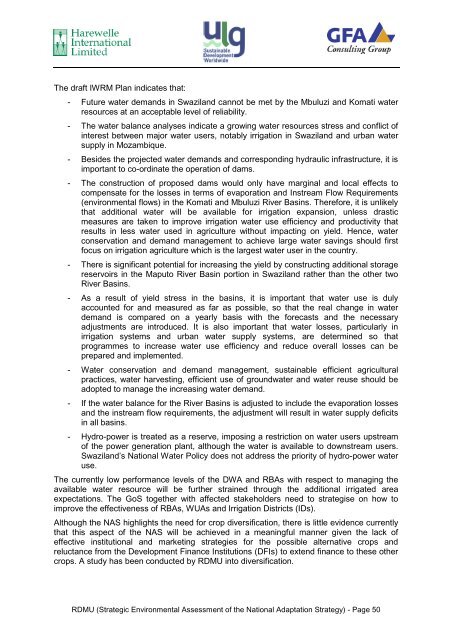Service Contract No 2007 / 147-446 Strategic ... - Swaziland
Service Contract No 2007 / 147-446 Strategic ... - Swaziland
Service Contract No 2007 / 147-446 Strategic ... - Swaziland
- No tags were found...
Create successful ePaper yourself
Turn your PDF publications into a flip-book with our unique Google optimized e-Paper software.
The draft IWRM Plan indicates that:- Future water demands in <strong>Swaziland</strong> cannot be met by the Mbuluzi and Komati waterresources at an acceptable level of reliability.- The water balance analyses indicate a growing water resources stress and conflict ofinterest between major water users, notably irrigation in <strong>Swaziland</strong> and urban watersupply in Mozambique.- Besides the projected water demands and corresponding hydraulic infrastructure, it isimportant to co-ordinate the operation of dams.- The construction of proposed dams would only have marginal and local effects tocompensate for the losses in terms of evaporation and Instream Flow Requirements(environmental flows) in the Komati and Mbuluzi River Basins. Therefore, it is unlikelythat additional water will be available for irrigation expansion, unless drasticmeasures are taken to improve irrigation water use efficiency and productivity thatresults in less water used in agriculture without impacting on yield. Hence, waterconservation and demand management to achieve large water savings should firstfocus on irrigation agriculture which is the largest water user in the country.- There is significant potential for increasing the yield by constructing additional storagereservoirs in the Maputo River Basin portion in <strong>Swaziland</strong> rather than the other twoRiver Basins.- As a result of yield stress in the basins, it is important that water use is dulyaccounted for and measured as far as possible, so that the real change in waterdemand is compared on a yearly basis with the forecasts and the necessaryadjustments are introduced. It is also important that water losses, particularly inirrigation systems and urban water supply systems, are determined so thatprogrammes to increase water use efficiency and reduce overall losses can beprepared and implemented.- Water conservation and demand management, sustainable efficient agriculturalpractices, water harvesting, efficient use of groundwater and water reuse should beadopted to manage the increasing water demand.- If the water balance for the River Basins is adjusted to include the evaporation lossesand the instream flow requirements, the adjustment will result in water supply deficitsin all basins.- Hydro-power is treated as a reserve, imposing a restriction on water users upstreamof the power generation plant, although the water is available to downstream users.<strong>Swaziland</strong>’s National Water Policy does not address the priority of hydro-power wateruse.The currently low performance levels of the DWA and RBAs with respect to managing theavailable water resource will be further strained through the additional irrigated areaexpectations. The GoS together with affected stakeholders need to strategise on how toimprove the effectiveness of RBAs, WUAs and Irrigation Districts (IDs).Although the NAS highlights the need for crop diversification, there is little evidence currentlythat this aspect of the NAS will be achieved in a meaningful manner given the lack ofeffective institutional and marketing strategies for the possible alternative crops andreluctance from the Development Finance Institutions (DFIs) to extend finance to these othercrops. A study has been conducted by RDMU into diversification.RDMU (<strong>Strategic</strong> Environmental Assessment of the National Adaptation Strategy) - Page 50
















